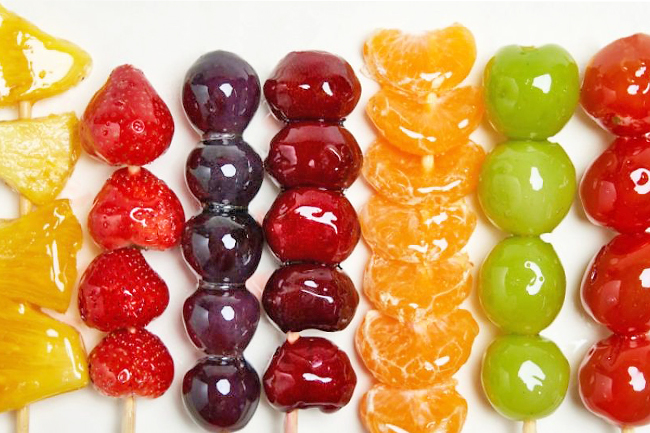ANN/THE KOREA HERALD – In addition to the sustained appeal of Korean classics, a succession of food trends has been injecting new culinary thrills into Korea, albeit with transient popularity.
These trendy edibles encompass diverse categories, from beverages and snacks to bread and noodles.
While some merely enjoy brief moments in the spotlight, others establish themselves as enduring favourites within the food industry.
Meanwhile, certain trends yield their temporary fame to emerging culinary sensations.
Currently reigning supreme are Chinese candied fruit tanghulu and Meoktaekkang, a new twist on Korea’s beloved classic snack Saewookkang. Yet, the question lingers: Will their popularity stand the test of time?
THE SOLD-OUT EFFECT
The desire for novel culinary experiences is often influenced by a variety of factors, but one of the key drivers is people’s heightened interest in products that are limited in supply or have low availability.
In short, people desire an item more when it’s hard to get.
The late 2014 phenomenon surrounding Honey Butter Chip illustrates the power of the sold-out effect and its potential pitfalls for manufacturers.



With word-of-mouth and viral social media reviews fueling the hype surrounding this sweet and savoury potato chip, snack manufacturer Haitai Confectionery and Foods witnessed explosive sales growth.
Within a three months of its launch, the sweet treat raked in sales totaling KRW13.7 billion (USD10.2 million).
As demand continued to surpass supply, the firm decided in mid-2015 to add a new production line, which was completed the next year. By the time, supply was increased, however, demand had already petered out.
According to data from the Food Information Statistics System, Honey Butter Chip sales last year amounted to approximately KRW20.7 billion, ranking 14th on the list of Korean snacks sold that year.
The latest snack craze is Nongshim’s fish-flavoured Meoktaekkang, launched in June last year, which is experiencing soaring popularity to such an extent that it now commands premium prices on secondhand online platforms.
For these snack crazes driven by the sold-out effect, experts point to the combination of relatively affordable food prices and low supply that offer a sense of instant gratification for consumers.
“The desire to hop on new trends often finds an easy outlet through food products, which are more readily affordable than excessively priced luxury items,” explained professor of social sciences Choi Chul at Sookmyung Women’s University.
He also placed the act of purchasing the products ahead of the actual tasting experience, saying, “People often develop a strong desire to acquire these sellouts. It stems from the urge to participate in the event and demonstrate to others that they possess something unique.”
“I recall the media and everyone talking about how scarce Honey Butter Chip was in supply,” said resident of Gyeonggi Province Lee Yoon-hwa in her 50s.
“That was the sole reason my family became interested in the snack. We imagined the snack must be somehow different, although the first bite was not exceptionally surprising,” she added.
THE VIRAL EFFECT
Professor of consumer science Lee Young-ae at Incheon National University, highlighted the role of social media in disseminating and fuelling food crazes.
“Nowadays, many use social media to showcase their food-related experiences, seeking a sense of accomplishment and recognition through comments,” she explained.
In the past, online eating broadcasts known as mukbang on YouTube – where viewers experience visual and auditory sensations by watching the hosts eat – were particularly instrumental in disseminating food trends.
In 2014, for instance, the “fire noodle challenge” featuring Buldak Ramen erupted on YouTube, successfully establishing the Buldak Ramen series as a prominent brand although the noodle challenge remains an ongoing phenomenon primarily in foreign countries as of now. With newly emerging social media platforms in the late 2010s like Instagram and TikTok, snappy, short videos and posts about food have become an integral part of today’s food trends.
A search for #tanghulu in Korean on Instagram returned over 140,000 posts as of this month, signifying its status as one of the most talked-about food items at the moment.
For 12-year-old Kwon Min-jae, a resident of Seoul, the tanghulu craze is presented in a range of brief, attention-grabbing content.
Kwon noted that he not only indulges in consuming content related to eating and cooking the sugar-coated fruit, but also shares his eating experiences with friends on social media.
He even further embarks on tanghulu tasting adventures with them. “Sharing the diverse flavours of tanghulu with my friends after school is quite an enjoyable experience,” he said.
Indeed, the snack’s fame has soared on the back of viral videos and posts on social media that draw people in with its colourful visuals and crunchy sounds.
According to data released by Woowa Brothers, which runs Korea’s top food delivery app Baedal Minjok, searches for tanghulu has surged 47.3 times in July this year compared to January on the platform.
Professor Choi elaborated on the motivation behind people’s quest for culinary experiences, attributing it to their desire to engage with the latest mainstream trend.
“Continuous exposure to trendy foods in the social media world spur people to seek out firsthand experiences,” Choi explained. – No Kyung-min




